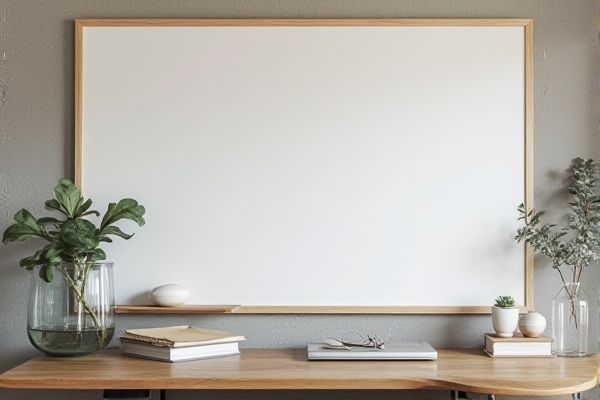
Pinboards offer a tactile way to organize and display notes or reminders using pins, making them ideal for physical documents and quick visual reference, while dry erase boards provide a versatile, reusable surface to write and erase messages, charts, or plans with ease. Explore this article to discover which option best suits Your workspace and productivity style.
Table of Comparison
| Feature | Pinboard | Dry Erase Board |
|---|---|---|
| Material | Cork, fabric, or foam | Glossy white surface (melamine or porcelain) |
| Usage | Pin notes, photos, documents | Write and erase with markers |
| Reusability | Reusable with push pins | Highly reusable, easy to erase |
| Maintenance | Minimal, occasional cleaning | Requires regular cleaning to prevent ghosting |
| Durability | Depends on material, prone to pinholes | Durable, scratch resistant (porcelain) |
| Visual Clarity | Varies with pinned items | Clear, bright writing surface |
| Cost | Generally low | Varies, often higher than pinboards |
Introduction: Pinboard vs Dry Erase Board
Pinboards provide a tactile surface for attaching paper notes, reminders, and photos using pins, making them ideal for organizing physical documents and visual displays. Dry erase boards offer a smooth, erasable surface for writing and drawing with markers, perfect for dynamic brainstorming sessions and quickly updating information. Both tools enhance workspace organization but serve distinct purposes based on the need for permanent display or flexible, reusable writing space.
Overview of Pinboards
Pinboards provide a tactile and visually accessible surface for pinning notes, photos, and reminders using pushpins, making them ideal for quick organization and regular updates. Unlike dry erase boards, pinboards maintain posted content without the risk of accidental erasure, offering a durable and static display option suitable for both personal and professional environments. Your workspace benefits from the textured cork or fabric surface, enhancing the ease of attaching various materials compared to the smooth, erasable surface of dry erase boards.
Overview of Dry Erase Boards
Dry erase boards are reusable writing surfaces coated with a glossy finish that allows for easy writing and erasing with dry erase markers. Widely used in classrooms, offices, and meeting rooms, they facilitate dynamic presentations, brainstorming sessions, and collaborative work by enabling quick updates and changes. Unlike pinboards, dry erase boards do not involve pins or tacks, making them ideal for fluid communication without physical clutter.
Key Differences Between Pinboards and Dry Erase Boards
Pinboards use cork or fabric surfaces for pinning notes, photos, or documents with pushpins, offering a tactile and lasting way to display information. Dry erase boards feature smooth, glossy surfaces designed for writing and erasing with dry erase markers, enabling quick updates and easy content changes. Pinboards excel in visual organization of physical items, while dry erase boards provide dynamic, reusable writing space ideal for brainstorming and presentations.
Materials and Durability Comparison
Pinboards are typically made from cork or fabric-covered foam, offering a soft surface ideal for pinning papers securely, while dry erase boards feature a smooth, non-porous surface made from materials like melamine, porcelain, or glass, designed for easy writing and wiping. Cork pinboards provide moderate durability but may wear down over time with frequent pin use, whereas porcelain dry erase boards are highly durable, resisting stains and scratches better than melamine or glass alternatives. Your choice depends on whether you need a tactile surface for pins or a sleek, reusable writing space that withstands daily use.
Ease of Use and Maintenance
Pinboards offer effortless ease of use by allowing you to quickly pin notes, photos, or reminders using push pins without any special tools or preparation. They require minimal maintenance since there's no need for cleaning, just occasional rearranging of pins or replacing of tacks. Dry erase boards demand regular wiping to remove marker residue, which can stain over time, making maintenance more involved compared to the simple upkeep of pinboards.
Versatility and Functionality
Pinboards offer high versatility by allowing you to easily attach notes, photos, and documents with pushpins, making them ideal for organizing physical materials in offices or classrooms. Dry erase boards provide enhanced functionality through smooth surfaces for quick writing and erasing, perfect for brainstorming sessions, presentations, and dynamic planning. Your choice depends on whether you prioritize tangible displays or interactive, reusable writing space.
Aesthetic and Design Options
Pinboards offer versatile aesthetic and design options with customizable fabric colors, frames, and pin styles that complement various interior decors, making them suitable for both professional and casual environments. Dry erase boards present a sleek, modern appearance with smooth, glossy surfaces available in frameless or minimalist frame designs, enhancing contemporary office or classroom settings. Both options allow for personalized use but differ in visual impact, where pinboards provide a tactile, textured look while dry erase boards emphasize clean, streamlined aesthetics.
Cost and Budget Considerations
Pinboards generally offer a more budget-friendly option compared to dry erase boards, with lower initial costs and minimal maintenance expenses. Dry erase boards often require purchase of markers, erasers, and cleaning solutions, which can add up over time. For your workspace, choosing a pinboard can be a cost-effective solution if you prioritize affordability and low upkeep.
Best Applications and Use Cases
Pinboards excel in organizing and displaying physical documents, photos, and notes, making them ideal for classrooms, offices, and creative studios where tactile interaction is preferred. Dry erase boards offer reusable, easy-to-update surfaces perfect for brainstorming sessions, presentations, and collaborative workspaces that require frequent changes and clear visibility. You can enhance productivity by selecting a pinboard for long-term displays and a dry erase board for dynamic, real-time communication.
 homyna.com
homyna.com